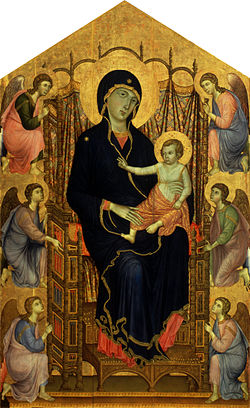Rucellai Madonna
 |
|
| Artist | Duccio di Buoninsegna |
|---|---|
| Year | 1285 (commissioned) |
| Type | Tempera and gold on panel |
| Dimensions | 450 cm × 290 cm (180 in × 110 in) |
| Location | Uffizi Gallery, Florence |
|
|
The Rucellai Madonna is a panel painting by the late medieval Italian painter Duccio di Buoninsegna from Siena. Originally painted for the Societa di S Maria Virginis for Florence's Santa Maria Novella church, the painting now resides in the Uffizi Gallery in the same city. The painting depicts the Virgin and Child enthroned, surrounded by angels on a gold background.
The altarpiece was commissioned by the Compagnia dei Laudesi for the Santa Maria Novella church in Florence. The Rucellai Madonna is Duccio's earliest work for which there is documentation. The work was designed for the main altar of the church, but the current name reflects its later use in the Rucellai family's chapel, situated within the church. In a contract dated 15 April 1285, Duccio was commissioned to paint a panel for which he was to be paid 150 lire. The contract's only requirements were that the Virgin and Child and "other figures" should be present, but gave no other instructions as to its contents or style. The document stated that if the final work failed to please, the artist would retain possession of the painting and no payment would be made.
In the 16th century, the art historian Giorgio Vasari mistakenly attributed the Rucellai Madonna to Duccio's contemporary, Cimabue, in his Lives of the Most Eminent Painters, Sculptors, and Architects. This mistake went unchallenged for centuries; in the 19th century Frederic Leighton was to show the Rucellai Madonna paraded through the streets in his first major painting, which bore the title Cimabue's Celebrated Madonna Carried in Procession (1853-5). In 1889, however historian Franz Wickhoff compared stylistic choices between the Rucellai Madonna and Duccio's Maestà, and soon other critics agreed that Duccio had indeed painted the Madonna.
The work, measuring 4.5 by 2.9 meters, may be the largest surviving painting of Italian 13th century art. It is tempura on a five-pieced poplar panel; the frame is of the same wood. The Virgin's robe was found during its 1989 cleaning to be azurite-based paint. The Virgin is shown looking directly at the viewer, as the Christ Child is seen sitting on her lap, giving a blessing. The Madonna is large in scale, taking up the majority of the frame. Her robe is finely modelled and her gold halo incised as if to illuminate her presence. Duccio's use of gold represents the family's holiness and the unearthly realm they inhabit. Six angels are seen holding the ornate throne, and are painted in shades of green, pink, lilac and blue. Their positions in front and behind the throne suggest they are either lifting it up, or bringing it down to earth. The frame is decorated with thirty roundels containing portraits of Apostles, prophets, saints and patriarchs. It is clear from the attention to detail that Duccio was highly concerned with idealism and beauty, rendering each figure softly, with delicate features and adoration.
...
Wikipedia
